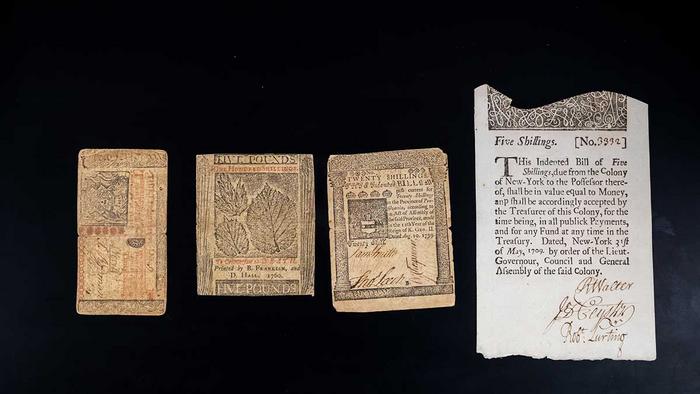When he wasn’t busy inventing the lightning rod and bifocals, electrocuting turkeys, or serving as a diplomat to France during the American Revolution, 18th century polymath Benjamin Franklin was also innovating the printing of paper money. A study published on July 17 in The Journal Proceedings of National Academy of Sciences (PNAS) found that Franklin may have printed almost 2,500,000 money notes for the colonies that would become eventually become the United States’ currency. Franklin used some original methods.
[Related: What exactly is a digital dollar, and how would it work?]
The study team analyzed approximately 600 notes, some of which Franklin himself printed, and some that were counterfeits.
“Benjamin Franklin saw that the Colonies’ financial independence was necessary for their political independence. Most of the silver and gold coins brought to the British American colonies were rapidly drained away to pay for manufactured goods imported from abroad, leaving the Colonies without sufficient monetary supply to expand their economy,” study co-author and physicist at the University of Notre Dame Khachatur Manukyan said in a statement.
The Thirteen Colonies were unable to print money because of counterfeiting. Currency has evolved over time, and while the earliest known paper money dates back to the Tang Dynasty in China (CE 618–907), paper notes were a relatively new concept in the Colonies when Franklin opened his printing house in 1728. Without traditional gold or silver, paper money’s lack of value meant it was at risk of depreciating. There were no standard bills during the Colonial period, which gave counterfeiters plenty of chances to pass off fake notes as genuine.
Franklin created security features to make his bills more distinctive.
“To maintain the notes’ dependability, Franklin had to stay a step ahead of counterfeiters,” said Manukyan. “But the ledger where we know he recorded these printing decisions and methods has been lost to history. Using the techniques of physics, we have been able to restore, in part, some of what that record would have shown.”

In the study, the team used spectroscopic and imaging instruments to take a closer look at the fibers, inks, and paper that made Franklin’s bills stand out—and made them difficult to replicate. The team found that the pigments Franklin used are more distinct, and that counterfeit gills have high amounts of calcium or phosphorus. However, these materials were only found in trace quantities on authentic Franklin bills.
Franklin used a special graphite-based black dye in his currency, but he used lamp black to print most of his work. This pigment is also different from one called bone black, made from burned bones and favored by counterfeiters and those outside of Franklin’s printing house network.
[Related: Fake Galileo manuscript suspected to be a 20th-century forgery.]
The paper printed by Franklin’s network also has a distinctive look due a translucent material they identified as muscovite. The study team speculates that adding muscovite initially began to make Franklin’s printed notes more durable, and continued when it was a helpful counterfeit deterrent.
Manukyan says that working with rare and archived materials is not common in physics laboratories. It posed a special challenge, but also proved the importance of multidisciplinary work.
“Few scientists are interested in working with materials like these. Some of these bills are unique. They need to be handled with extreme caution and can’t be damaged. Those are constraints that would turn many physicists off to a project like this,” he said.




